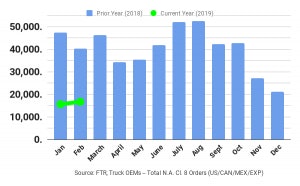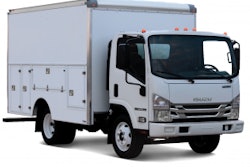 Click to enlarge.
Click to enlarge.Preliminary North America Class 8 truck net order numbers indicate a 5 percent increase compared with January, but a 58 percent decrease from year-ago February, according to ACT Research and FTR. ACT reports the industry booked 16,900 units last month and FTR is reporting 16,700 units.
“February marks the third consecutive month of orders meaningfully below the current rate of build. Over that three-month period, Class 8 orders have been booked at a 194,000 SAAR (seasonally adjusted annual rate),” says Kenny Vieth, ACT president and senior analyst.
“Even though orders are well off their year-ago highs, a trend that is expected to persist through most of this year, we continue to believe that current order weakness has more to do with the very large Class 8 backlog and orders already booked than with the current erosion of the truck-to-freight supply-demand balance,” Vieth says.
Preliminary Class 5-7 truck net order data show that segment of the industry remains on trend, according to ACT.
“Classes 5-7 orders rose sequentially in February, staying on trend at 25,200 units and rising 9.3 percent from January,” says Vieth. “On a year-over-year basis, medium-duty orders fell 5 percent from last February against a tough year-ago comparison. Seasonal adjustment reduced February’s volume, making it identical to January, as well as to the order trend that started in the second half of 2018.”
ACT notes these numbers are preliminary. Complete industry data for February, including final order numbers, will be published by ACT Research in mid-March.
Regarding Class 8 trucks, FTR says, several OEM’s are booked solid for 2019 with limited sales slots open for the remainder of the year, so orders are likely to stay in this depressed range until 2020 order boards are opened up. The weaker orders mean that backlogs will tumble for the second straight month, but they remain at historically high levels. Class 8 orders for the past 12 months have now totaled 429,000 units.
“Fleets that need to order trucks are looking for any available open build slot, regardless of brand. Specifying is also more difficult as the supply chain for parts and components stays tight. Production continues at high rates, as OEMs build those record orders that were placed in 2018,” says Don Ake, FTR vice president of commercial vehicles.
“The freight market started off the year strong and carriers have still been able to hire enough drivers to expand their fleets. Trucking capacity is not in the chaotic state it was in 2018, but business remains vibrant. Some moderation in freight growth is expected in the second half of the year and this should loosen things up a bit,” Ake says.
Final data for February will be available from FTR later in the month as part of its North American Commercial Truck & Trailer Outlook service.









